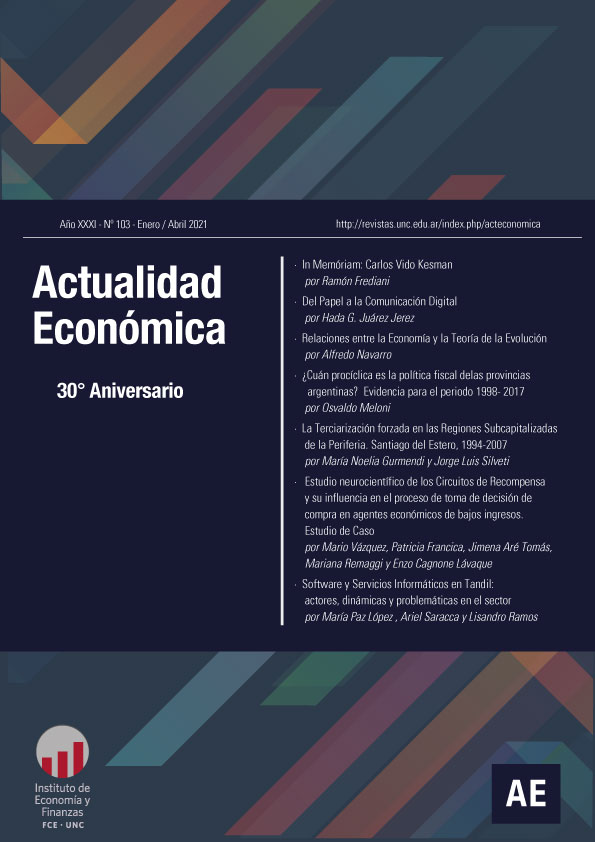Relations between Economics and Evolutionary Theory
Keywords:
evolutionary economics, natural selection, routinesAbstract
This paper studies the relationship between economics, biology and the theory of evolution. It begins by analysing the influence that both Malthus and the early economists had on the birth of the theory of natural selection. It then looks at the reverse relationship, i.e. the transmission of ideas from evolutionary theory to economic thought, studying the ideas of Marshall, Veblen, Hayek and Schumpeter, among others. It then analyses the current state of so-called evolutionary economics, analysing the most important recent contributions, highlighting the influence of Schumpeter's ideas. Finally, some reflections are made on the topics discussed.
Downloads
References
Alchian, A. (1950). “Uncertainty, evolution, and economic theory”. Journal of Political Economy, 58, 211-221.
Anyadike-Danes, M. y Hart, M. (2018). "All grown up? The fate after 15 years of a quarter of million UK firms born in 1998". Journal of Evolutionary Economics 28.
Arrow, K. (1995). “Viewpoint: The Future”. Science 267, 17, 17 de marzo.
Boulding, K. E. (1991). “What is evolutionary economics?”. Journal of Evolutionary Economics 1(1).
Carpintero, O. (2012). "Kenneth E. Boulding: más alla de la economía". Revista de Economía Crítica. 14, 2° semestre.
Crespo, R. (2016). Keynes, filósofo práctico. Buenos Aires: Fondo Editorial Consejo Profesional de Ciencias Económicas.
Crow, J. (1995). “Motoo Kimura (1924-1994)”. Genetics. 140. 1-5.
Darwin, C. [1871] (1957). The Descent of Man. Londres: Penguin Books.
Darwin,C. [1871] (2004). The Descent of Man. Londres: Penguin Books.
Dawkins, R. (1976). The Selfish Gene. Oxford: Oxford University Press.
Dawkins, R. (2010). The Greatest Show on Earth. Nueva York: Free Press.
Dollimore, D. y Hodgson, G. (2014). "Four essays in economic evolution: an introduction". Journal of Evolutionary Economics, 24:1.
Dopfler, K. (ed.) (2005). The Evolutionary Foundations of Economics. Cambridge: Cambridge University Press.
Faucett, H. (1860). "A Popular Exposition of Mr. Darwin Origin of Species". Macmillan Magazine. vol. III, n. 14.
Fishburn G. (1995) "Henry Fawcett: His role in the Darwinian Revolution". History of Economics Review. 24:1.
Friedman, M. (1953). "The Methodology of Positive Economics". En Essays in Positive Economics. Chicago:The University of Chicago Press, 3-46.
Groenewegen, J. (1998) A soaring eagle: Alfred Marshall. Nueva York: Edward Elgar
Harrod, R. (1958). La vida de John Maynard Keynes. Ciudad de México: Fondo de Cultura Económica.
Hayek, F. (1988). The Fatal Conceit. Chicago. Chicago University Press.
Heymann, D.; Perazzo, R. y Zimmermann, M. G. (2008). Modelos económicos con múltiples agentes. Working paper. Universidad de San Andrés.
Hodgson, G. (2001). "¿Is Social Evolution Lamarckian or Darwinian?", en Laurent, J. y Nightingale, J. (eds.). Darwinism and Evolutionary Economics. Cheltenham: Edward Elgar.
Hume, D. [1886] (2003). Historia Natural de la Religión. Madrid: Editorial Trotta S.A.
Kendrick, D.; Mercado P. y Amman, H. (2006). Computational Economics. Princeton: Princeton University Press.
Keynes, J.M. [1933] (1981). Essays in Biography. Cambridge: Macmillan-Cambridge University Press.
Keynes, J.) [1936] (1945). Teoría general de la ocupación, el interés y el dinero. Ciudad de México: Fondo de Cultura Económica.
Kimura, M. (1983). The neutral theory of molecular evolution. Cambridge: Cambridge University Press.
Knudsen, T. (2001). "Nesting Lamarckism within Darwian Explanations", en Laurent, J. y Nightingale, J. Darwinism and Evolutionary Economics. Cheltenham: Edward Elgar.
Langlois, R. y Everett, M. (1993). "What is Evolutionary Economics", en Magnuson, L. (ed.) Evolutionary and Neo-Schumpeterian Approaches to Economics. Boston: Kluwer Academic Pub.
Louça, F. y Perlman, M. (eds.) (2000). Is Economics an Evolutionary Science? The legacy of Thorstein Veblen. Cheltenham: Edward Elgar.
Lowry, S. T. (1987). The Archeology of Economic Ideas. Durham: Duke University Press.
Magnusson, L. (1994). Evolutionary and Neo-Schumpeterian Approaches to Economics. Boston: Kluwer Academic Publishers.
Malthus, T. [1817] (1963). Principle of Population. Homewood: Richard Irwin Inc.
Marshall, A. [1890] (1948). Principios de Economía. Aguilar.
Nelson, R. (1973) "Recent Exercises in Growth Accounting: New Understanding or Dead End?" American Economic Review, 63: 462-468.
Nelson, R., Dosi, G., Helfat, C., Pyka, A., Winter, S., Saviotti, P., Lee, K., Malerba, F., Dofffer, K. (2018). Modern evolutionary economics: an overview. Cambridge: Cambridge University Press.
Nelson, R. y Winter, S. (1974). "Neoclassical vs. Evolutionary Theories of Economic Growth: and Prospectus". Economic Journal 84: 886-905.
Nelson, R. y Winter, S. (1982). An Evolutionary Theory of Economic Change. Cambridge: Harvard University Press.
Orr, A. H. (2009). "Testing Natural Selection" Scientific American. vol. 300 núm. 1.
Popper, K.[1942] (1981). La sociedad abierta y sus enemigos. Barcelona: Ediciones Paidos.
Ridley, M. (2015). The Evolution of Everything. Nueva York: Harper Perennial.
Saviotti, P., Pyka, A. y Jun, B. (2016). TEVECON: Descripción del modelo. https://www.researchgate.net/292130135TEVECON_Description_of_Model
Schumpeter, J. [1911](1957). Teoría del desenvolvimiento económico. Ciudad de México: Fondo de Cultura Económica.
Schumpeter, J. [1942] (1963). Capitalismo, socialismo y democracia. Madrid: Aguilar.
Schumpeter, J. [1939] (1964). Business Cycles. Nueva York: McGraw-Hill Co.
Skousen, M. (2001). The Making of Modern Economics. Londres: Sharpe Inc.
Spencer, H. (1867). First Principles. Amazon. Versión Kindle.
Veblen, T. (1898). “Why is Economics not an Evolutionary Science”. Quarterly Journal of Economics, vol 12.
Downloads
Published
Issue
Section
License

This work is licensed under a Creative Commons Attribution-NonCommercial-NoDerivatives 4.0 International License.
Those authors who have published with this journal, accept the following terms:
Authors will conserve their copyright and guarantee the magazine the right of first publication of their work, which will be simultaneously subject to the Creative Commons Attribution-NonCommercial-NoDerivative 4.0 International License that allows third parties to share the work as long as the author and first publication of this magazine are indicated.
Authors may adopt other non-exclusive license agreements to distribute the published version of the work (e.g., deposit it in an institutional telematic archive or publish it in a monographic volume) provided that the initial publication in this journal is indicated.
Authors are allowed and encouraged to disseminate their work through the Internet (e.g., in institutional telematic archives or on their website) before and during the submission process, which may lead to interesting exchanges and increase citations of the published work. (See The effect of open access)









